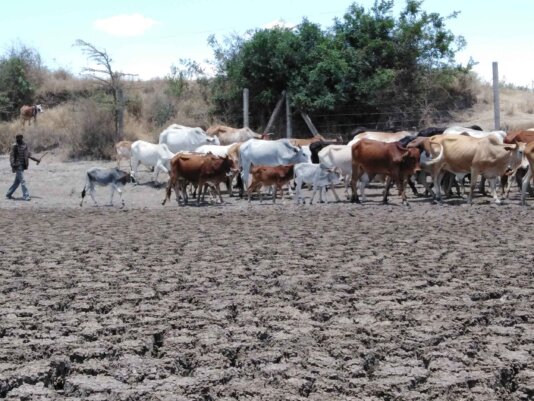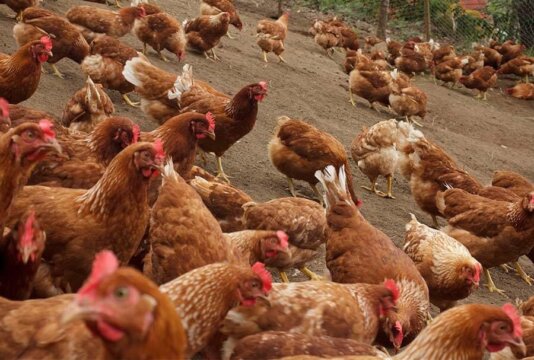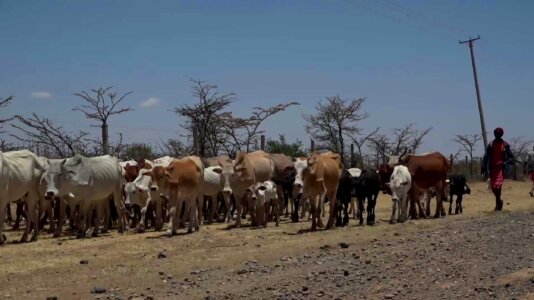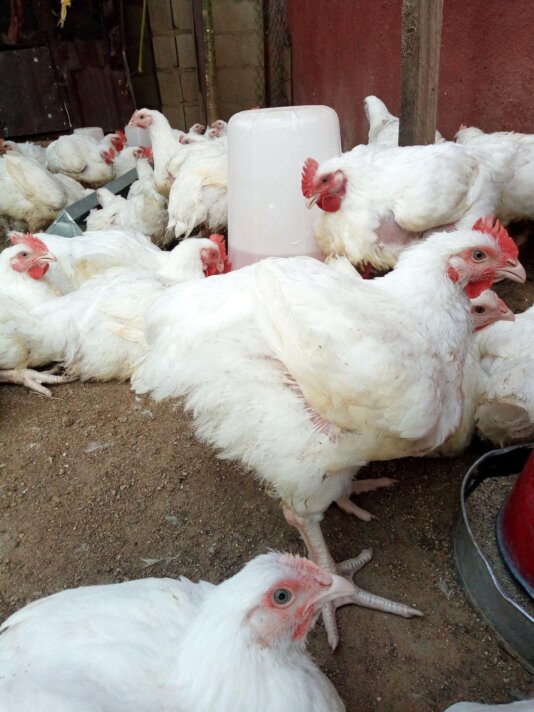- About
- Topics
- Story
- In-Depth
- Picks
- Opinion
- News
- Donate
- Signup for our newsletterOur Editors' Best Picks.Send
Read, Debate: Engage.
| December 18, 2023 | |
|---|---|
| topic: | Food Security |
| tags: | #Kenya, #food security, #animal feed, #sustainable farming |
| located: | Kenya |
| by: | Shadrack Kavilu |
Decades of persistent drought and famine, reaching a peak in Kenya and neighbouring countries in the Horn of Africa pose a serious threat to the country's livestock sector, which is a critical source of livelihood for millions.
The ongoing, climate change-induced drought has caused the failure of both crop and livestock fodder, leading to the substantial loss of millions of livestock.
Kenya has endured five consecutive seasons of drought from 2020 to 2023.
The situation has resulted in the cost of animal feed skyrocketing to an all-time high, making it unaffordable for most small-holder livestock farmers. Currently, a 70 kg bag of dairy meal is priced at USD 19.65, layers at USD 29.4 and growers marsh at USD 22.9, varying based on company brands.
Grace Munanie, a poultry farmer from Kamulu, a town located some 27 kilometers (16.7 miles) east of Kenya’s capital Nairobi, is contemplating abandoning her back-yard poultry farm and invest in a more commercially viable enterprise.
The expense of feeding her flock of over one thousand chickens is becoming increasingly unsustainable.
Munanie, a mother of four, has been supplying eggs and chickens for over three years. However, the recent prolonged drought in the East African region has caused a scarcity of animal feed, compelling her to sell her chickens at lower prices to local restaurants.
"With this high cost of animal feeds I can no longer sustain this business," she lamented.
A year ago, she said, 70 kilogrammes of layer mash used to cost USD 16.4 (Ksh 2,500). Today, the same amount retails at USD 31 (Ksh 4,700), while chick-mash is sold at USD 32 (Ksh 4,900) - an increase of over 22 per cent.
"To feed a thousand birds with these kinds of higher prices has increased my cost of doing business, hence I cannot make a profit out of it," she told FairPlanet. "Competition by supermarkets that are importing eggs cheaply from markets such as South Africa and Asia have flooded supply."
Munanie is one of thousands of livestock farmers across the country grappling with the exorbitant cost of livestock feeds and fodder, a challenge worsened by the impacts of climate change and the Ukraine-Russia war, which has disrupted the importation of raw feed products.
While the Kenya livestock sector contributes about 12 per cent to the Gross Domestic Product (GDP), the shortfall in livestock feed and fodder shortage is threatening the livelihoods of millions of livestock, people and employment opportunities across the value chain.
According to the Economic Survey 2023 published by the Kenya National Bureau of Statistics (KNBS), the number of cattle and calves slaughtered increased by 11.6 per cent from 2.0 million heads in 2021 to 2.2 million heads in 2022.
Similarly, sheep, goats and pigs slaughtered also increased by 14.9 per cent and 9.5 per cent to 10.8 million heads and 389,300 heads in 2022, respectively.
"The increase in number of livestock slaughtered was largely attributed to increased offtake as a mitigation measure due to shortage of pasture as a result of prolonged drought," says KNBS.
The nation is grappling with a staggering 60 per cent feed deficit, which is equivalent to a significant shortfall of about 2.6 billion bales of feed and it also faces a 46 per cent post-harvest loss, according to a report by the African Union- InterAfrican Bureau for Animal Resources (AU-IBAR).
The shortage, according to AU-IBAR statistics, could further affect food access and nutrition security in the country. The prolonged drought has led to the loss of over 9.5 million animals in the horn of Africa, according to a report by the World Bank.
Kenya's livestock sector feed deficit is so dire that the Competition Authority of Kenya (CAK), a government state agency, in early October started investigating feed manufacturers who are suspected of manipulating feed prices and creating an artificial feed shortage.
CAK, as the agency stated, will seek to identify and address obstacles hindering the entry and expansion of smaller feed producers. It will scrutinise aspects such as demand and supply dynamics, market share distribution, ownership relationships and potential joint ventures, suspecting that these factors may be contributing to the elevated feed prices.
"The key objective of the market inquiry is to assess the market interaction, market structures, market outcomes, and other factors that may be affecting competition in markets along the animal feed value chains and recommend interventions that will support sustainable growth and competitive markets for a robust animal feeds sector in Kenya," CAK acting director-general Adano Roba told the Business daily newspaper.
Roba added that the key objective of the market inquiry is to identify barriers along the animal feed value chain and recommend interventions that will support sustainable animal feed production.
The sheer deficit in feed and fodder is significantly impacting Kenya's livestock sector, a critical contributor to the country's economy estimated at around USD 1 billion annually.
The International Feed Industry Federation (IFIF) reports that global compound feed production exceeds one billion tonnes annually, and that commercial feed manufacturing on a global scale contributes to an estimated annual turnover surpassing USD 400 billion.
Kenya faces a significant shortfall in meeting the feed requirements for its livestock sector, needing 55 million metric tonnes annually but currently supplying only 40 per cent. Nearly half of the available feed, about 46.3 per cent, is lost to post-harvest losses.
Kenya, along with other countries in the Horn of Africa, has been exploring different interventions to address the livestock feed deficit and enhance agricultural production. But despite initiating mechanisms to strengthen the livestock value chain, experts say that existing efforts are fragmented, with significant gaps in data, efficiency and coordination.
The country is developing a Livestock Master Plan (LMP) with the help of the Nairobi-based International Livestock Research Institute (ILRI) and in partnership with the African Union InterAfrican Bureau for Animal Resources (AU-IBAR) Resilient African Feed and Fodder Systems Project (RAFFS) to tackle these challenges.
Sirak Bahta, a senior agricultural economist at the ILRI, said the livestock master plan offers evidence-based guidance that allows governments to plan timely interventions.
A long-term strategy, Bahta said, can address systemic issues like declining cattle populations, animal feed, disease management and preserving indigenous breeds.
The master plan collects comprehensive feed data from various livestock production systems, taking into account different agro-ecological zones and farm systems.
"This allows for a thorough understanding of the variations in feed parameters," Bahta said. "For instance, for ruminants, some parameters include the type and quantity of feed provided to animals, the availability of grass, the size of grazing land and the amount of crop residues.
"By capturing these details, the LMP calculates the country's feed balance within different agro ecological zones and identifies specific constraints requiring interventions."
The anticipated outcome of the LMP is increased investment from both public and private sectors, which would result the sector's inclusive and sustainable growth.
The livestock master plan is being piloted by Elgeyo Marakwet County as the government plans to launch the project nationwide.
"This, in turn, is expected to enhance livestock productivity, increase employment and incomes, reduce poverty and improve food and nutrition security."
The country is also banking on another project recently launched by the RAFFS, which is headquartered in Ethiopia, and seeks to respond to livestock feed and fodder shortages posed by the triple C crises: Covid-19, Climate Change and the Conflict between Russia and Ukraine.
The RAFFS project will build resilience in African feed and fodder systems by focusing on establishing a knowledge and analytical ecosystem for evidence-based solutions and supporting business models and partnerships to address short-term feed and fodder shortages.
The project also aims to empower women in feed and fodder systems and reform policies and regulations in the industry to make it more sustainable.
Food experts say that the effective implementation of the livestock master plan, the resilient feed and fodder system project and participation in the African Continental Free Trade Area could assist Kenya and the region in reducing their over-reliance on food imports.
"Africa's food import bill is over USD 60 billion annually, adopting a single market under the African Continental Free Trade Area will boost trade, alleviate poverty, and improve nutritious food supplies," said African Union Special Envoy on Food Systems, Dr Ibrahim Mayaki.
Dr Mayaki urged small-scale farmers, who contribute approximately 80 per cent of Africa's food production, to play a central role in an agricultural revolution. He further emphasised the importance of leveraging the African Continental Free Trade Area, which has the potential to decrease the continent's current annual food import bill.
Image by Shadrack Kavilu.
By copying the embed code below, you agree to adhere to our republishing guidelines.




